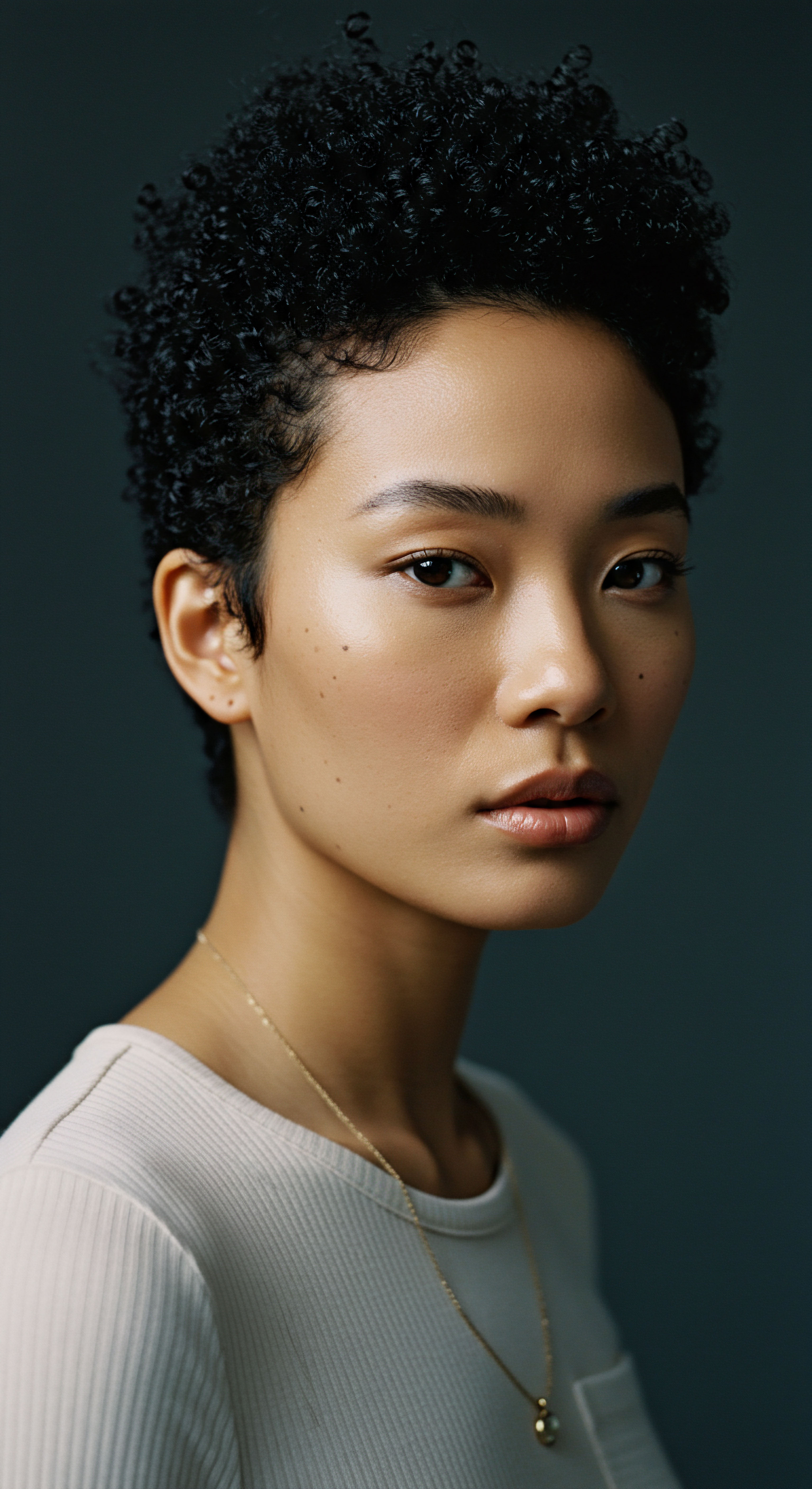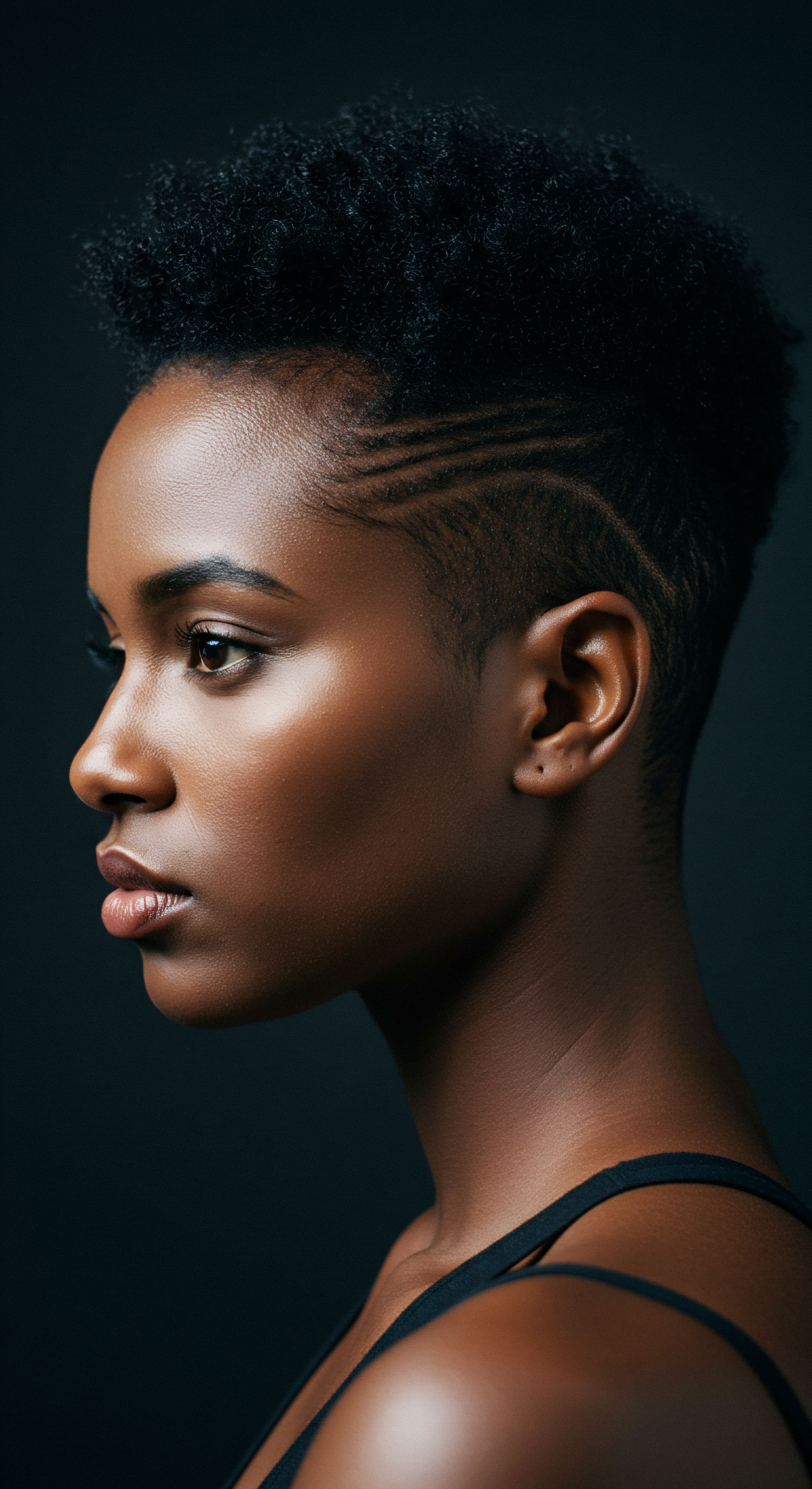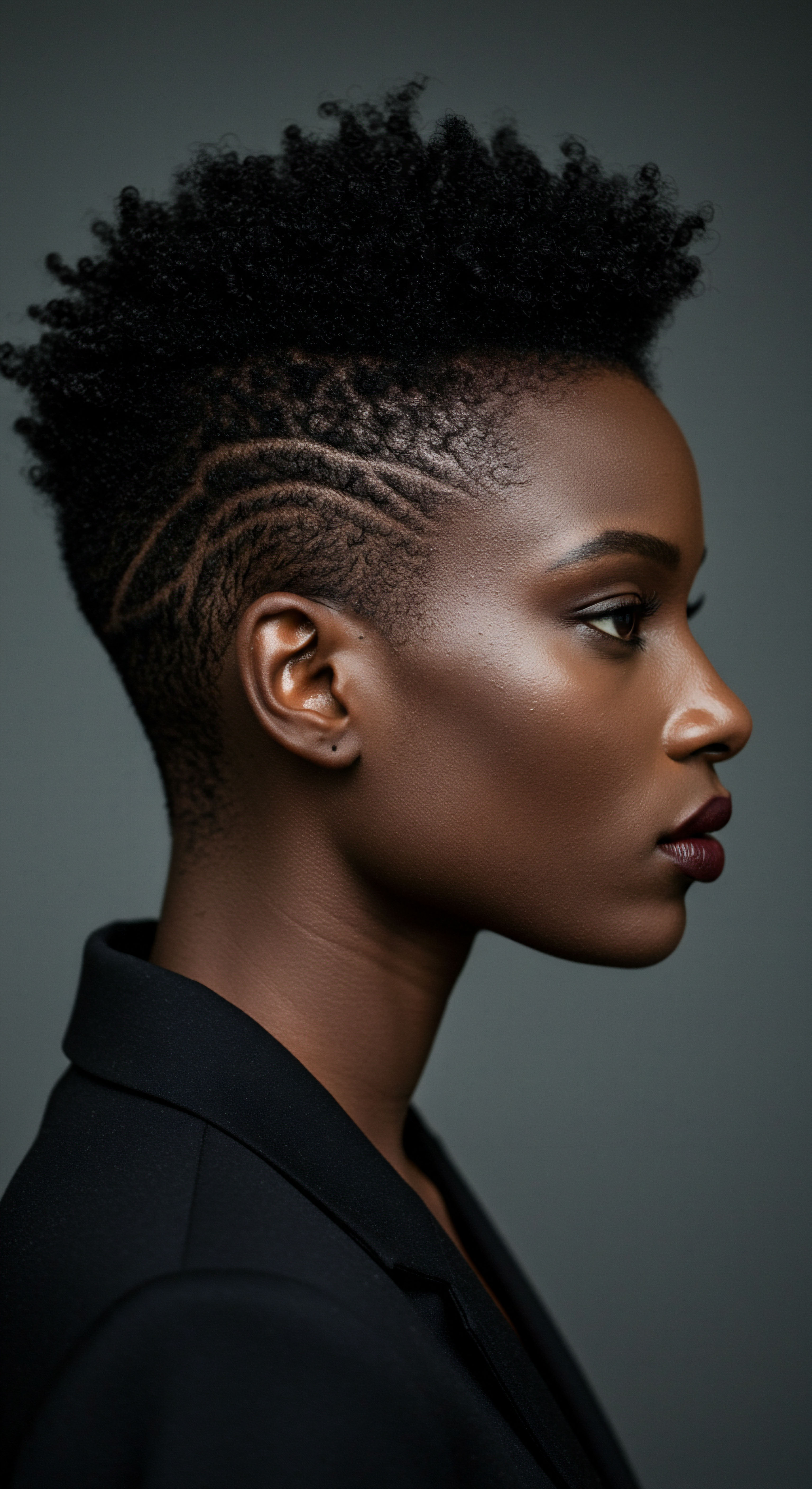
Roots
Consider the timeless human desire for adornment, for self-expression, for comfort in the world’s varying climates. This ancient impulse found a particularly distinctive form along the Nile, where the sun held sway and hygiene was a daily pursuit. The question of whether ancient Egyptians removed their wigs at night reaches into the very fabric of their daily existence, their values, and their relationship with personal presentation.
It asks us to look beyond static museum displays and envision the dynamic lives of people who lived thousands of years ago, navigating a landscape where practicality and aesthetic ideals often converged. The wigs, far from mere accessories, served as extensions of identity, protectors against the elements, and symbols of social standing.

What Did Ancient Egyptian Wigs Mean to Their Wearers?
For the ancient Egyptians, wigs represented more than just a stylistic choice; they were a multifaceted solution to environmental and societal needs. The intense Egyptian sun, a constant presence, made head coverings a practical necessity. Wigs provided a protective barrier, shielding the scalp from harsh rays, which was especially pertinent for those who opted to shave their natural hair. This practice, prevalent among priests and many members of the elite, served to maintain ritual purity and cleanliness, reducing the incidence of head lice, a common concern in ancient times.
The construction of these wigs speaks volumes about their importance. Crafted with meticulous care, the finest examples used human hair, a commodity valued as highly as gold in their barter economy. Wigmakers skillfully braided human hair into numerous small plaits, affixing them to a mesh foundation.
Beeswax and animal fat often held these intricate styles in place, ensuring their durability in the arid climate. Less opulent wigs might incorporate plant fibers or sheep’s wool, making these hairpieces accessible across various social strata, though the most elaborate were reserved for the wealthy, signifying their elevated position.
Ancient Egyptian wigs were essential items, serving as both practical solutions for climate and hygiene, and potent markers of social standing.
The archaeological record supports the widespread use of wigs, with evidence dating as early as 3400 BCE. Tomb paintings and sculptures frequently depict individuals adorned with elaborate hairpieces, reflecting the prevailing fashion of different periods. These representations allow us to trace the evolution of styles, from the shorter bobs of the Old Kingdom to the more voluminous and decorated creations of later dynasties. The very presence of wigs in funerary contexts further underscores their perceived importance, ensuring the deceased appeared well-groomed and of high standing in the afterlife.
Beyond their practical and social functions, wigs held a symbolic weight. Hair itself was considered a representation of vitality and personal energy. The careful grooming and adornment of one’s head, whether with natural hair or a wig, conveyed a sense of order and readiness for the world. The act of wearing a wig could also be seen as a way of presenting an idealized self, a perfected image for both earthly interactions and the spiritual journey beyond.

Ritual
Stepping into the daily routines of ancient Egyptians, one begins to appreciate the rhythms that shaped their lives. The wearing of wigs was not a static display, but an active component of their personal care and public presentation. Considering the construction of these elaborate hairpieces, held together with beeswax and resin, the question of their nighttime removal becomes a matter of practicality and comfort, alongside their primary functions.

How Were Wigs Integrated Into Daily Grooming?
Daily grooming in ancient Egypt was a significant undertaking, extending beyond simple cleanliness to encompass a refined sense of personal presentation. Wigs were a central element of this routine. Both men and women, particularly among the elite, shaved their heads or kept their natural hair very short, creating a smooth base for their wigs.
This practice served multiple purposes ❉ it minimized the presence of head lice, a persistent issue, and offered relief from the intense heat of the desert climate. The wig, with its mesh-like foundation, allowed for some air circulation, a benefit over solid head coverings.
The application of oils and unguents to the scalp and natural hair beneath the wig was also common. These substances, often derived from plants like almond or castor oil, served to condition the scalp, provide a pleasant scent, and potentially offer additional protection against sun and insects. The careful preparation of the head before donning a wig suggests a thoughtful, almost ritualistic approach to personal care.
Wigs were integral to daily presentation, providing hygiene and sun protection atop carefully prepared natural hair.
The maintenance of these wigs was also a regular practice. Wigmakers and hairdressers were skilled professionals, tending to the hairpieces to keep them in pristine condition. This care would have involved cleaning, restyling, and repairing the wigs, ensuring they retained their shape and luster. The very nature of this maintenance suggests that wigs were not permanently attached but rather donned and doffed as needed.
Consider the types of materials used ❉
- Human Hair ❉ The most prized material, often meticulously braided and arranged.
- Plant Fibers ❉ Such as linen, used for more economical wigs or as filler.
- Animal Hair ❉ Including sheep’s wool or horsehair, particularly after the Hyksos period.
- Beeswax and Resin ❉ Applied to set styles and add sheen, providing structure and durability.
The daily wear of wigs extended to various social settings and occasions. Simpler wigs were worn for everyday activities, while more elaborate, decorated pieces were reserved for festivals, ceremonies, and public appearances. This distinction further supports the idea of wigs as removable garments, chosen to suit the context of the day. The weight and size of some royal wigs, such as the one worn by Queen Isimkheb (circa 900 BCE), which was so substantial she required assistance to stand, would have made continuous wear, particularly during sleep, highly impractical.

Were Wigs Removed Before Sleep?
While direct textual evidence detailing nighttime wig removal is scarce, practical considerations strongly suggest that ancient Egyptians would have removed their wigs before sleep. The primary reasons for wearing wigs—hygiene, sun protection, and aesthetic presentation—are largely daytime concerns. Sleeping in a heavy, structured wig, particularly one treated with beeswax and resin, would have been uncomfortable, hot, and detrimental to the wig’s intricate styling. The materials used to set the hair, while durable, would not have withstood constant pressure and friction from sleep without damage.
Furthermore, the emphasis on personal cleanliness in ancient Egyptian society, including daily bathing and shaving, indicates a preference for a clean body and head. It is reasonable to assume that removing the wig would have been part of a broader nighttime cleansing ritual, allowing the scalp to breathe and any natural hair to be tended to. This would also have allowed for the airing and preservation of the wig itself, extending its lifespan.
| Material Human Hair |
| Primary Use Elite wigs, high status |
| Characteristics Finest quality, natural appearance |
| Material Plant Fibers |
| Primary Use Filler, less expensive wigs |
| Characteristics Lightweight, accessible |
| Material Animal Hair |
| Primary Use Blended wigs, specific textures |
| Characteristics Added volume, diverse options |
| Material Beeswax & Resin |
| Primary Use Styling agent, hold |
| Characteristics Stiffens, provides shine, durable |
| Material These components allowed for both elaborate styling and practical application in the Egyptian climate. |

Relay
The enduring allure of ancient Egypt often prompts us to seek answers beyond simple observations, pushing us to consider the deeper currents of their daily existence. The query regarding nighttime wig removal, while seemingly straightforward, opens pathways to understanding their sophisticated approach to personal care, social expression, and even their beliefs about the body’s condition for the afterlife. This investigation calls for a look into the scientific analyses that reveal the hidden aspects of their grooming practices, providing a more textured view than historical texts alone might offer.

What Do Scientific Discoveries Tell Us About Ancient Hair Care?
Modern archaeological science offers fascinating insights into ancient Egyptian hair care, often confirming what we might surmise from art and texts. Studies on mummified remains provide tangible evidence of their grooming habits. Researchers, including Natalie McCreesh from the University of Manchester, have analyzed hair samples from mummies, revealing the application of fat-based products.
This “hair gel,” as it has been termed, contained long-chain fatty acids, including palmitic and stearic acids. Its purpose was to hold hairstyles in place, not just for life but also for the afterlife, suggesting a meticulous concern for appearance even in death.
One particular study found that hair from some mummies was coated in this fatty substance, yet showed no evidence of natron salts, which were used in the body’s mummification process. This suggests that the hair was either protected during the embalming of the body or treated as a separate entity, receiving its own specialized preservation to maintain its style. The individuality of the deceased, including their coiffure, was clearly a consideration in the mummification procedures.
Scientific analysis of mummy hair reveals intricate styling agents, suggesting a deliberate effort to preserve appearance for eternity.
This scientific observation holds weight when considering daily wig practices. If hair was so carefully styled and preserved even for eternity, it stands to reason that daily wigs, worn by the living, would have been equally valued and maintained. The fatty substances used to set the wigs, while effective for holding elaborate styles, would have created a stiff, perhaps even greasy, texture. Sleeping with such a hairpiece would have been uncomfortable and could have caused damage to the wig’s structure or transferred oils to bedding.
The presence of head lice in ancient Egyptian hair, as documented by Joann Fletcher, provides another layer of context. Wigs served as a practical defense against these pests, especially for those who shaved their heads. Regular removal of the wig would have allowed for cleaning of both the scalp and the wig itself, which would have been essential for effective lice prevention and general hygiene. It is plausible that the wigs were cleaned, aired, and perhaps re-oiled or re-waxed during the nighttime hours, allowing them to be fresh for the next day’s wear.

Did Social Expectations Influence Nighttime Practices?
Social standing played a considerable role in ancient Egyptian life, and personal appearance was a visual signal of one’s place in society. Elite men and women wore elaborate wigs as markers of their high status. The grandeur of a wig often correlated with wealth and influence. This emphasis on public presentation suggests that the wigs were primarily for daytime display.
The resources dedicated to wig creation and maintenance also point to their daytime function. Wigmakers were skilled artisans, and their products were valuable. The investment in such a significant item would logically lead to practices that prolonged its life and maintained its appearance. Allowing a wig to be crushed or distorted during sleep would be counterproductive to its value and its role as a status symbol.
Consider the detailed processes involved in wig care ❉
- Cleaning ❉ Wigs would require regular cleaning to remove dust, oils, and any accumulated debris.
- Restyling ❉ The intricate braids and curls would need to be refreshed and reset with beeswax and resin.
- Repair ❉ Over time, individual strands might loosen or detach, necessitating repair by a skilled wigmaker.
These processes are more conducive to a wig being off the head for a period, rather than being worn continuously.
The archaeological finding of wig boxes, such as the one discovered with a human hair wig from Thebes (now in the British Museum), further supports the idea of wigs being removed and stored. These containers would have protected the hairpieces from dust and damage, preserving their shape and condition for future wear. This simple act of storage speaks volumes about the value placed on these items and the care taken to maintain them.
In conclusion, while direct declarations about nightly wig removal are not found in ancient texts, the convergence of practical considerations, scientific analysis of hair care products, and the societal value placed on wigs strongly indicates that these elaborate headpieces were indeed removed at night. This allowed for personal hygiene, preservation of the wig’s structure, and a clear distinction between public presentation and private comfort.

Reflection
The question of ancient Egyptian wig practices, seemingly a small detail, opens a window into a culture where personal presentation was deeply interwoven with daily life, spiritual belief, and social standing. It prompts us to consider the ingenious ways in which people adapted to their environment and expressed their identities through adornment. The dedication to grooming, the ingenuity in crafting elaborate hairpieces, and the careful preservation of these items even beyond life, all paint a picture of a society that understood the profound connection between outward appearance and inner self. This enduring human inclination to care for one’s crown, whether natural or artfully constructed, continues to resonate through the ages, reminding us of our shared history with those who walked the earth long ago.

References
- Fletcher, Joann. “Ancient Egyptian Hair ❉ A Study in Style, Form and Function.” Unpublished PhD thesis, University of Manchester, 1995.
- Fletcher, Joann and Filippo Salamone. “An Ancient Egyptian Wig ❉ Construction and Reconstruction.” Internet Archaeology 42, 2016.
- Lowery, Allison. “Historical Wig Styling ❉ Ancient Egypt to the 1830s.” 2nd ed. Routledge, 2020.
- Lucas, Alfred. “Ancient Egyptian Materials and Industries.” Edward Arnold, 1930.
- Manniche, Lise. “Ancient Egyptian Hairdressing.” British Museum Press, 1999.
- McCreesh, Natalie, et al. “Ancient Egyptian hair gel ❉ New insight into ancient Egyptian mummification procedures through chemical analysis.” Journal of Archaeological Science 38, no. 11 (2011) ❉ 2841-2846.
- Robins, Gay. “Hair, Gender, and Social Status in Ancient Egypt.” JSTOR Daily, 2020.
- Strudwick, Helen. “The Encyclopedia of Ancient Egypt.” Amber Books, 2006.